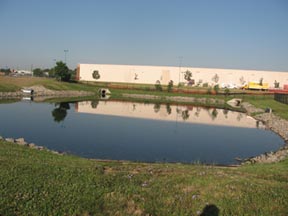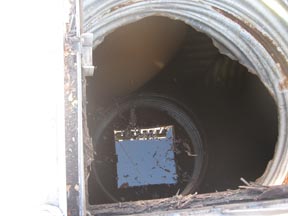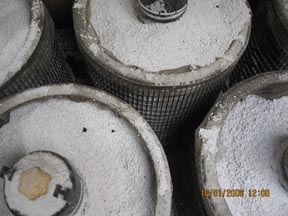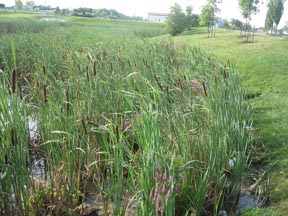

| MAINTENANCE |
Detention basins require regular inspection and maintenance to ensure that they are functioning properly. Homeowners Associations and business owners are entirely responsible for maintaining their detention basins. Poorly maintained basins, regardless of their design, lose their ability both to control flooding on private property and prevent pollutants like sediments, fertilizers and pesticides from entering the creeks and streams near homes and businesses. At Enviro-Stormwater Management, we can develop a maintenance program to save you time and money. INSPECTION OF INLET AND OUTLET PIPES Inlet Pipes direct stormwater from developments into detention basins, including stormwater from residential yards, driveways and roads. Typically, there are two to three inlet pipes in a detention basin.
If any of these problems are occurring, or if you have questions, contact Enviro-Stormwater Management.
Pump stations are very common methods of removing stormwater from detention basins; however, they also require routine maintenance. Essentially, an outlet pipe directs the water from the detention basin to the wetwell of the pump station. Once the depth of water in the wetwell reaches a specific level, a submersible pump turns on and pumps the water to the nearby creek or larger storm sewer system. Regular maintenance should include the following:
All litter and debris should be removed from stormwater facilities. Our maintenance programs will provide this service on an as needed basis. Underground detention devices need special equipment such as vactor trucks to remove accumulated trash and there must be a Confined Space Entry Permit issued before entering. SEDIMENT All stormwater facilities collect sediment. A regular scheduled maintenance program to remove sediment twice a year will cut down on major removal costs. Enviro-Stormwater Management has specialized equipment to removes accumulated sediment in ponds and underground facilities. All our crews are trained in Confined Space Entry and Rescue. MEDIA REPLACEMENT
A newer filter cartridge system is found in a lot of current systems. Where some inspection/maintenance companies will simply say the filter cartridges need replacement every two years at Enviro-Stormwater Management we will conduct a random sampling of cartridges to determine the life left in the media. This could save you tens of thousands of dollars over a short amount of time. EROSION All eroded areas should be repaired. Check for gullies or sloughing of the banks. Any damage observed should be repaired immediately by filling any eroded areas with topsoil and seeded. Enviro-Stormwater Management always repairs disturbed areas with erosion control blankets to expedite germination and insure the repair lasts.
Maintenance activities will vary depending on the type of basin. If you have a stormwater marsh basin, dead cattails and other decomposing vegetation in the basin should be removed if they are clogging pipe openings. Living vegetation greatly improves the water quality by filtering out pollutants such as fertilizers, pesticides, oils and grease, etc. Late fall is a good time to cut down cattails. This will minimize clogging in the spring by dead vegetation. Cut cattails should be disposed of with other compost materials. Remove invasive non-native plants. MOWING Specialized slope mowers and equipment are necessary for a lot of basins. The amount of mowing required depends on the type of detention basin and the desired appearance. Typically, basins with turf grass only need to be mowed two or four times a year. Enviro-Stormwater Management will develop a mowing schedule for your particular budget and basin. Basins with native grasses and wildflower plantings should be mowed only once a year in the late fall or early spring. More frequent mowing will prevent the wildflowers from blooming and producing seed. Pathways through wildflower plantings can be mowed more frequently. VERMIN CONTROL Most basins are not designed to be habitats for borrowing animals. They can cause damages to slopes and dams and cause erosion that could cause dam failures. Beavers are also a danger to properly functioning basins. Enviro-Stormwater Management will humanely remove vermin. RECORD KEEPING Enviro-Stormwater Management will help your HOA or business setup record keeping of all inspections including the date, name of inspector, what was observed, and maintenance activities performed.
|
Copyright © 2009 Enviro-Stormwater Management
Site designed and maintained by Sonjara, Inc
 WHAT TYPE OF MAINTENANCE IS REQUIRED?
WHAT TYPE OF MAINTENANCE IS REQUIRED? Outlet Pipes direct stormwater from a detention basin to a nearby creek or stream. Typically, there is only one outlet associated with a basin. The outlet may consist of a single pipe, a riser pipe, or it may be connected to a pump station. A common problem with Corragated Metal Pipe (CMP) outfall barrels in basins is that they corrode. Enviro-Stormwater Management has patented no-dig technology to repair outfall barrels and associated appertances.
Outlet Pipes direct stormwater from a detention basin to a nearby creek or stream. Typically, there is only one outlet associated with a basin. The outlet may consist of a single pipe, a riser pipe, or it may be connected to a pump station. A common problem with Corragated Metal Pipe (CMP) outfall barrels in basins is that they corrode. Enviro-Stormwater Management has patented no-dig technology to repair outfall barrels and associated appertances. LITTER AND DEBRIS
LITTER AND DEBRIS There are several different types of underground detention systems with a filter media. Sand filters are the most common and the filter media needs to replace when it is no longer functioning. Enviro-Stormwater Management will conduct visual and intrusive inspections of the media to determine when it needs to be replaced that will save your HOA or company money from unnecessary costly replacement.
There are several different types of underground detention systems with a filter media. Sand filters are the most common and the filter media needs to replace when it is no longer functioning. Enviro-Stormwater Management will conduct visual and intrusive inspections of the media to determine when it needs to be replaced that will save your HOA or company money from unnecessary costly replacement.  VEGETATION
VEGETATION